CHEVROLET CITATION 1980 1.G Manual PDF
Manufacturer: CHEVROLET, Model Year: 1980, Model line: CITATION, Model: CHEVROLET CITATION 1980 1.GPages: 95, PDF Size: 21.48 MB
Page 71 of 95
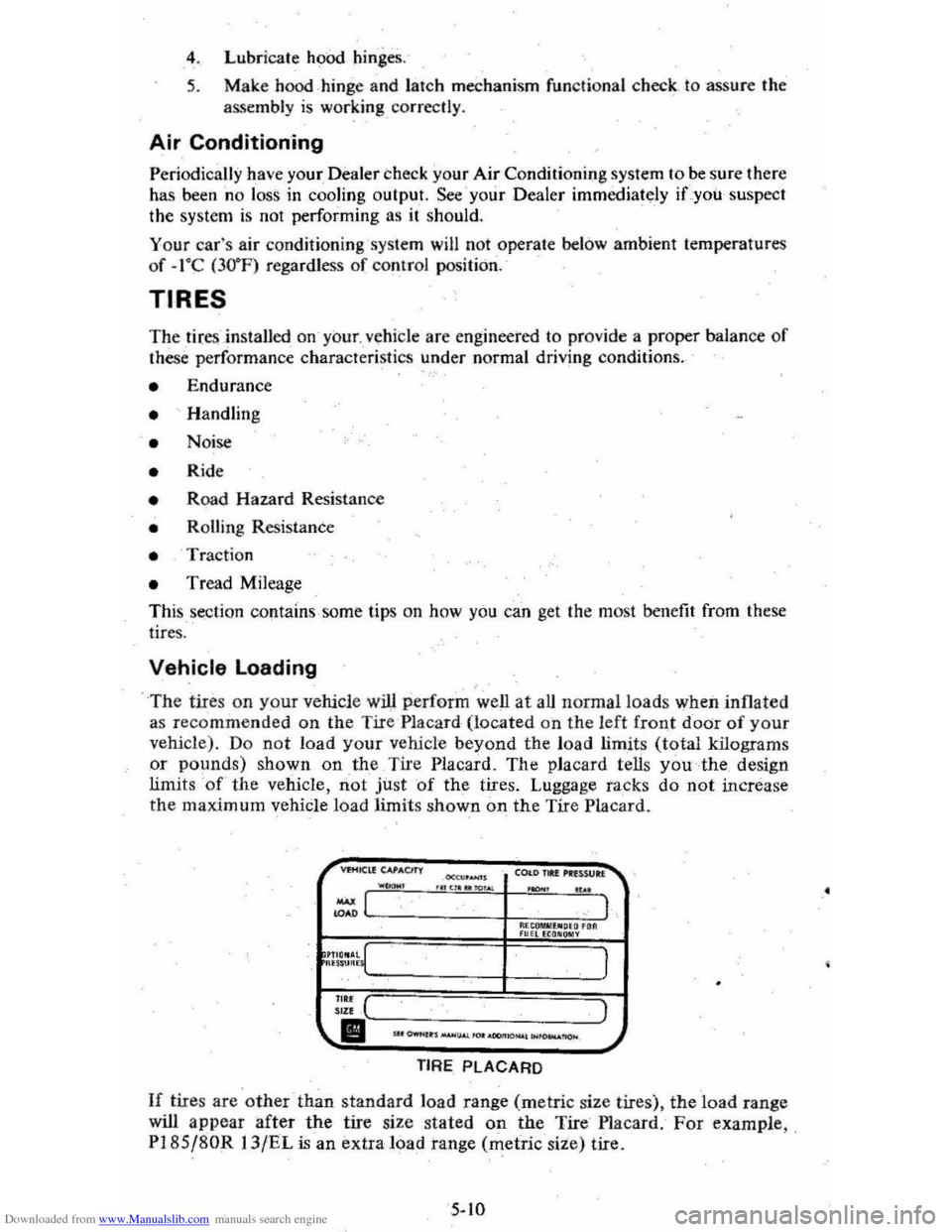
Downloaded from www.Manualslib.com manuals search engine 4. Lubricate hood hin 'ges.
5. Make hood -hinge and la tc h mechanism functiona l ch eck. to assure the
asse mbly
is working correctly.
Air Conditioning
Periodi cally have your Dealer check your Air Conditi oning system to be sure there
ha s been no loss in cooling output. See your Dealer immediat~ly if you suspect
the system
is not performing as it should.
Your car's air con dition ing'syste m will not operate below ambient temperatures of ~I"C (3(JF) regardless of co ntrol position.
TIRES
The tites ins tall ed on-your. vehicle are engineered to provide a proper balance of
these performa nce characteristics ~nder normal driving conditions.
• Endura nce
• Handlin g
• Noise
• Ride
• Road Hazard Resista nce
• Rolling Resistance
• Tractio n
• Tread Mileage
Thi s section contains some tips on how you can get the most benefit
from these
tire
s.
Vehicle Loading
-The tires on yo ur vehicl e -wil) perform well at aU normal loads w hen inflated
as recommended on the Tire Placa rd (located on the left front d -odr of your
vehicle) . Do not load your vehicle beyond the load limit s (total kilograms
or pounds) shown on the Tire Plac ard. The pla card tells you the design
limit s 'of' the vehicle, not just 'of the tires. Luggage tacks do not increase the maxim um vehicle load limits shown on the Tire Placard.
COI.DJIU ... nWb. .n, ... ~ ... .""". .. ..
~LC-----------·--t,M.~ro""'''~,."."''~. 1 F"HEca.~Y
I
::;: ( ) "" II''--.-,----.. -,--"-~--_-_--.-_-, .-,-_--_--'...J.J
TIRE PLACARD
If tire s are other -than standard load range (metric size tires), the load range
will
appear after the tire size stated on the Tire Placard . For example , , PI8S j80R 13/EL is an extra load tange (metric size) tire.
5-10
.'
Page 72 of 95
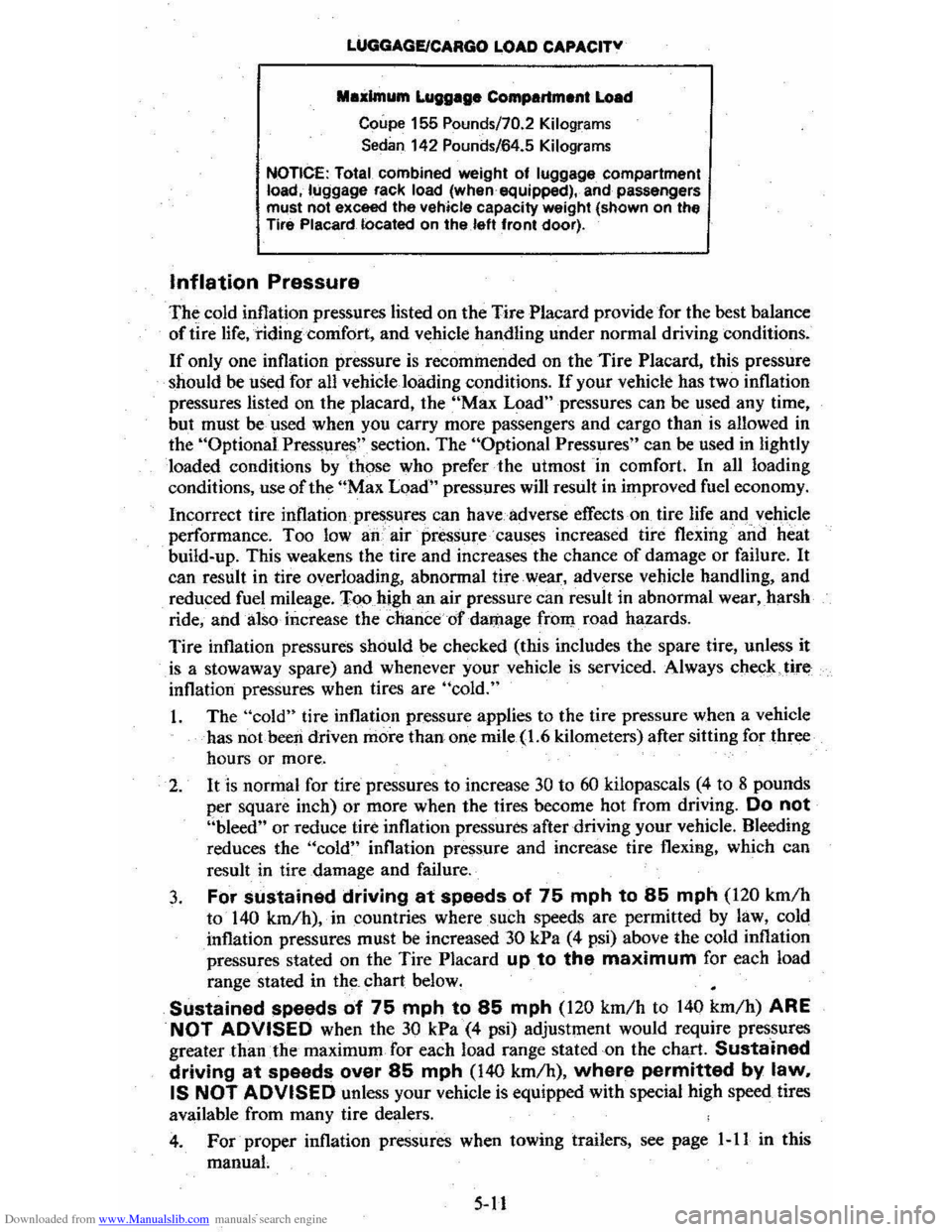
Downloaded from www.Manualslib.com manuals search engine LUGGAGE/CARGO LOAO CAPACITY
Maximum Luggage Compartment Load
Coupe 155 Pounds/70.2 Kilograms
Sedan 142 Pounds/64.5 Kilograms
NOTICE: Total combined weight of luggage compartment
load, luggage rack load (when-equipped) •. and passengers must not exceed the vehicle capacity weight (shown on the Tire Placard lOcated on the.left front door).
Inflation Pressure
The: cold inflation pressures listed on the Tire Placard provide for the best balance
of tire life, riding comfort. and vehicle handling under normal driving conditions.
If only one inflation pressure is recommended on the Tire Placard, this pressure
should be used for aU vehicle loading conditions. If your vehicle has two inflation
pressures listed on the placard, the "Max LDad" pressures can be used any time,
but must be used when you carry more passengers and cargo than is allowed in
the "Optional Pressures" section. The "Optional Pressures" can be used in lightly
loaded conditions by
'those who prefer the utmost in comfort. In all loading
conditions, use of the "Max Load" pressures will result in improved fuel economy.
Incorrect tire inflation pressures
can have adverse effects on tire life and_vehicle performance. Too Iowan" air pressure·"causes increased tire flexing and heat
build-up. This weakens the tire and increases the chance of damage or failure. It
can result in tire overloading, abnormal tire wear, adverse vehicle handling, and
reduced fuel mileage. 'I'oohigh
an air pressure can result in abnormal wear, harsh
ride, and also increase the chance of dar:nage from road hazards.
Tire inflation pressures should be checked (this includes the spare tire, unless it
is a stowaway spare) and whenever your vehicle is serviced. Always checJ<.,tire
inflation pressures when tires are "cold."
1. The "cold" tire inflation pressure applies to the tire pressure when a vehicle
has
not· been driven more than-one mile (1.6 kilometers) after sitting for three
hours or more.
2. It is normal for tire pressures to increase 30 to 60 kilopascals (4 to 8 pounds
per square inch)
or more when the tires become hot from driving. Do not "bleed" or reduce tire inflation pressures after driving your vehicle. Bleeding
reduces the
"cold" inflation pressure and increase tire flexing, which can
result in tire damage and failure.
3. FOr sustained driving at speeds of 75 mph to 85 mph (120 km/h to 140 km/h),in countries where such speeds are permitted by law, cold
inflation pressures must be increased
30 kPa (4 psi) above the cold inflation
pressures stated on the Tire Placard up to the maximum for each load
range stated in
the_ chart below.
Sustained speeds of 75 mph to 85 mph (120 km/h to 140 km/h) ARE
NOT ADVISED when the 30 kPa (4 psi) adjustment would require pressures greater than the maximum for each load range stated on the chart. Sustained
driving at speeds over 85 mph (140 km/h), where permitted by law. IS NOT ADVISED unless your vehicle is equipped with special high speed tires
available from many tire dealers.
4. Forproper inflation pressures when towing trailers, see page 1-11 in this
manuat
5-11
Page 73 of 95
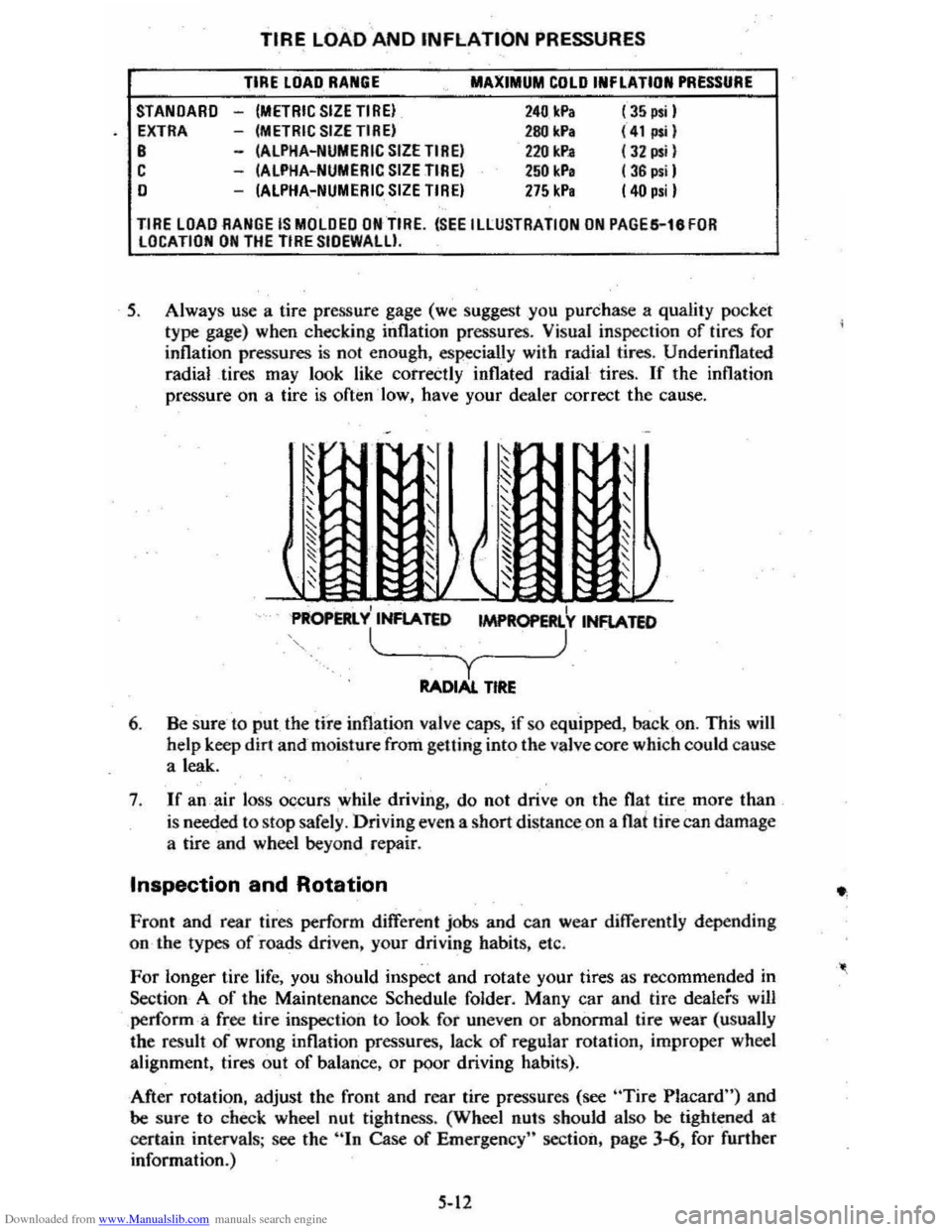
Downloaded from www.Manualslib.com manuals search engine STANDARD EXTRA B C o
TIRE LOAD AND INFLATION PRESSURES
TIRE LOAD RANGE
-(METRIC SIZETIREI -(METRIC SIZETIREI -(ALPHA-NUMERIC SIZE TIREI -(ALPHA-NUMERIC SIZE TIREI -(ALPHA-NUMERIC SIZE TIREI
MAXIMUM COLD INFLATION PRESSURE
240 Ic.Pa 280 kPa 2211 kP. 250 kP, 275 kP,
(35 psi I (41";1 (J2 psil ( 36 psil (40 p.iI
TIRE LOAD RANGE IS MOLDED ON TIRE. (SEE ILLUSTRATION ON PAGES-leFOR LOCATION ON THE TIRE SIOEWALU.
5. Always use a tire pressure gage (we suggest you purchase a quality pocket
type gage) when checking inflation pressures. Visual inspection of tires for
inflation pressures is nol enough, especially with radial tires. Underinflated
radial tires may look like correctly inflated radial tires.
If the inflation
pressure on a tire
is often ·low, have your dealer correct the cause.
, I PROPERlY INFlATED 1MPR0PERl Y INFlATED
l~_~~_~) y RADIAl. TIRE
6. Be sure to put the tire inflation valve caps, if so equipped. back on. This will help keep dirt and-moisture from getting into the valve core which could cause
a leak.
7 .
If an air loss occurs while driving. do not drive on the flat tire more than
is needed to stop safely . Driving even a short distance _on a flat tire can damage
a tire and wheel beyond repair.
Inspection and Rotation
Front and rear tires perform different jobs and can wear differently depending
on the types
of roads driven, your driving habits, etc.
For longer tire life, you should inspect and rotate your tires as recommended in
Section A
of the Maintenance Schedule folder. Many car and tire dealers will perform -a free lire inspection to look for uneven or abnormal tire wear (usually
the result of wrong inflation pressures, lack of regular rotation, improper wheel
alignment, tires out
of balance, or poor driving habits).
After rotation, adjust the front and rear tire pressures (see
"Tire Placard") and be sure to check wheel nut tightness. (Wheel nulS should also be tightened at
certain intervals ; see the
hIn Case of Emergency" section, page 3-6, for further
information.)
5-12
Page 74 of 95
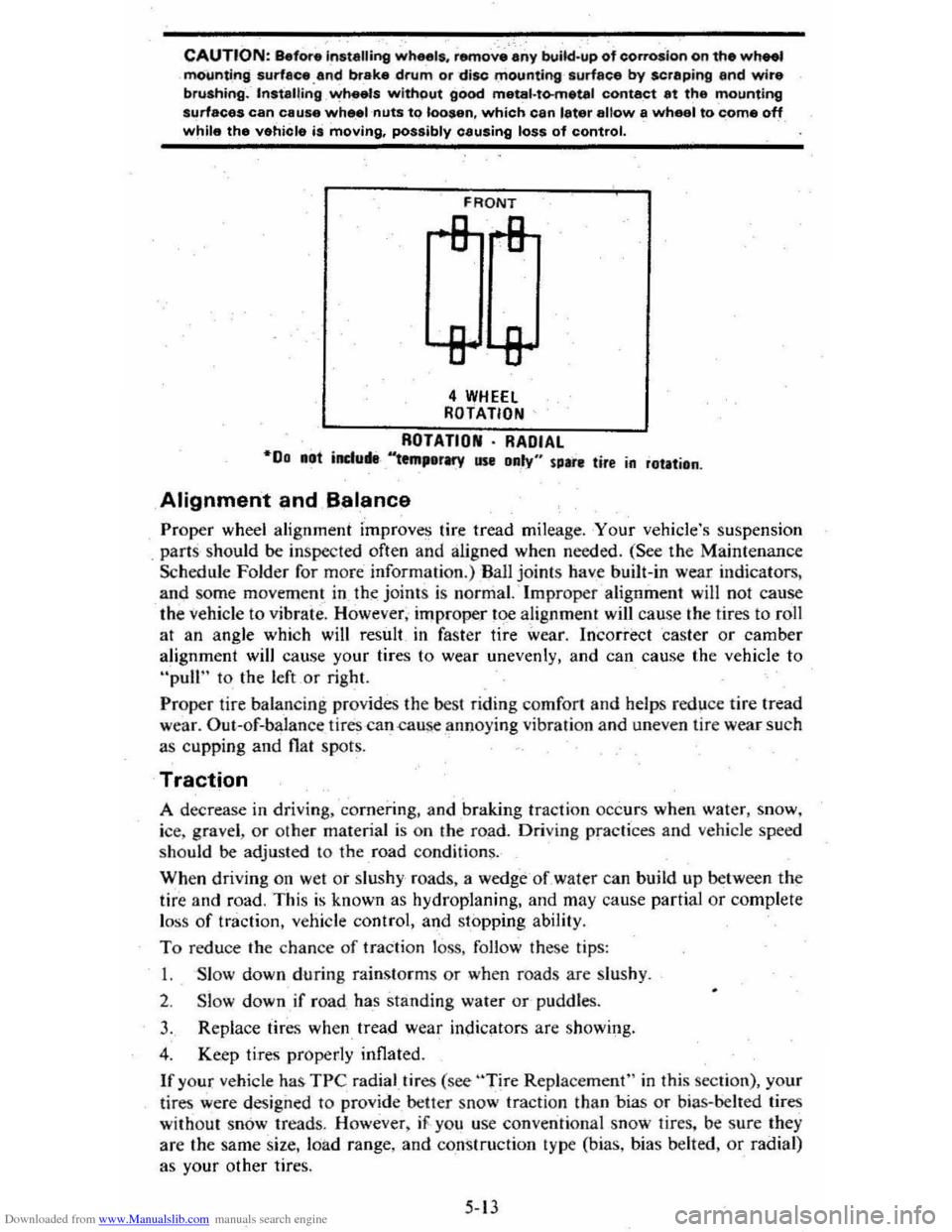
Downloaded from www.Manualslib.com manuals search engine CAUTION: BefOf"e Installing wheels. remo';.'~-~y build.up of corrosion on the wheel mOOnti_ng surfllce.and brake .drum or disc mounting surface by scrllping and wire brushing~-Installing ~h •• ls without good metal·to-metal contact at the mounting surfaces can cause whe.lnuts to loosen. which can later allow a wheel to c;ome off while the vehicle is moving. possibly causing loss of control.
FRONT
4 WHEEl ROTATION
ROTATION· RADIAL "00 .at induM-'''tm,erMY use Daly" sure tire in rotation .
Alignment and B.alance
Proper wheel alignment improves tire tread mileage . Your vehicle's suspension
. parts should be inspected often and aligned when needed. (See the Maintenance
Schedule Folder for m ore information.) Ball joints have built-in wear indicators,
and some movem ent in th~ joint s is normal. ' Improper alignment will not cause
the
vehicle to vibrate. However, improper toe alignment will cause the tires to roll
at an angle which will result in faster tire wear. Incorrect caster or camber
alignment will cause your tires to wear unevenly, and can cause the vehicle to
"pull" to the left or right.
Proper tire balan cing provides the best riding comfort and helps reduce tire tread
wear. Out--of-balan ce tires -can .cause annoying vibration and uneven tire wear such
as cupping and
flat spots.
Traction
A decrease in driving. cornerin g, and braking traction occurs when water, snow,
ice, gravel ,
or other material is on the road. Driving practices and vehicle speed
should be adjusted to the road condition~.
When driving on wet or slushy roads, a wedge -of water can build up between the
tire and road. This is known as hydroplaning, and may cause partial or complete
l oss
of traction, vehicle control, and stopping ability.
To reduce the chance of traction loss, follow these tips:
I. Slow down during rainstorms or when roads are Slu shy .
2. Slow down if road has standing water or-pUddles.
3. Replace tires when tread wear indicators are showing.
4 . Keep tires properly inflated.
If your vehicle has TPC radial.tires (see "Tire Replacement" in this section), your
lir es were design ed to
provide _ better snow tracti on than -bias or bias-belled tires
without snow treads. However , iF . yo u use conventional snow tires. be sure they
are the same size. loa d range, and construction type (bias, bias belted,
or radial)
as your other tire
s.
5-13
Page 75 of 95
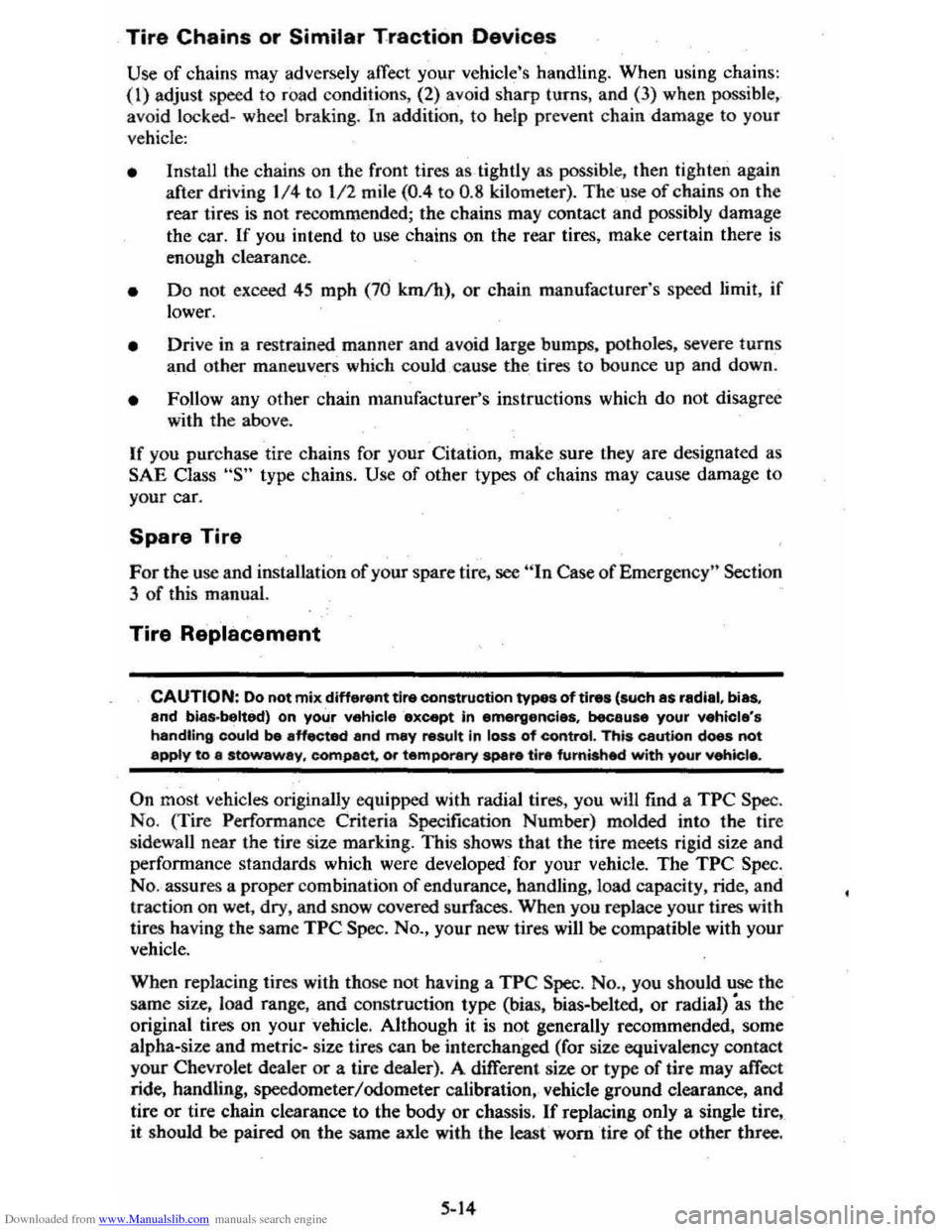
Downloaded from www.Manualslib.com manuals search engine Tire Chains or Similar Traction Devices
Use of chains may adversely affect your vehicle's handling. When using chains : (I) adjust speed to roa d conditions, (2) avoid sharp turns, and (3) when possible,
avoid
locked-wheel braking . In addition, to help preve nt chain -damage to your
vehicle:
• Install the chain s on the front tires as tightly as possible, then tighten again
after driving 114 to 1/2 mile (0 .4 to 0 .8 kilometer). The use of chains on the
rear tires is not recommended; the chains may contact and possibly damage
the
car. If you intend to use chains on the rear tires , m ake certain there is
enough clearance.
• Do not exceed 45 mph (76 km /h), or chain manufacturer's speed limit, jf
lower.
• Drive in a restrained manner and avoid large bumps. potholes, severe turns
and other maneuvers which could cause the tires to bounce up and down .
• Follow any other chain manufacturer's instructions which do no t disagre e
with the above.
If you purchase tire chains for your Citation, make sure they are designated as
SAE Class "S" type chains. U se of other types of chains may cause damage to
your car.
Spare Tire
For the use and installation of your spare tire, see "In Case of Emergency" Section
3
of this manual.
Tire Replacement
CAUTION: Do not mix different tire construction types of tires (such as rediel, bias, and bias.belted) on your vehieleexcept in emeruencies, because your vehicle's handling could be affected and may result In loss of contrOl. This caution does not a~y to 8 stowaway. compact,. or temporary spar. tlr. fumished with your vehtcle.
On most ve hicles originally equipped with radial tires, you will find a TPC Spec.
No. (Tir e Performan ce Criteria Specification Numbe-r) molded into the tire
sidewall ne
ar the tire size marking. This shows that the tire meets rigid size and
performanc e standards which were developed -for your vehicle. The TPC Spec.
No. assures a proper combination of endurance, handling, load capacity, ride, and
traction on wet , dry, and sn o w covered surfaces . When you re place your tires with
tires having the same
TPC Spec. No., your new tires will be co mpatible with your
vehicle.
When replacing tires with those not having a
TPC Spec. No., you should use the
same size, load range ,
and construction type (bias, bias-belted, or radial) "as the
original tires on your 'vehicle. Although it is not generally recommended. some
alpha-size and metri c- size tires can
be interchanged (for size equivalen cy contact
your Chevrolet dealer or a lire dealer). A different size or type of tire may affect
ride, handling, speedometer /odometer calibration, vehicle ground clearance, and
tire
or tire chain clearance to the body or chassis . If replacing only a single tire,
it should be paired on the same axle with the least worn tire of the other three.
5·14
Page 76 of 95
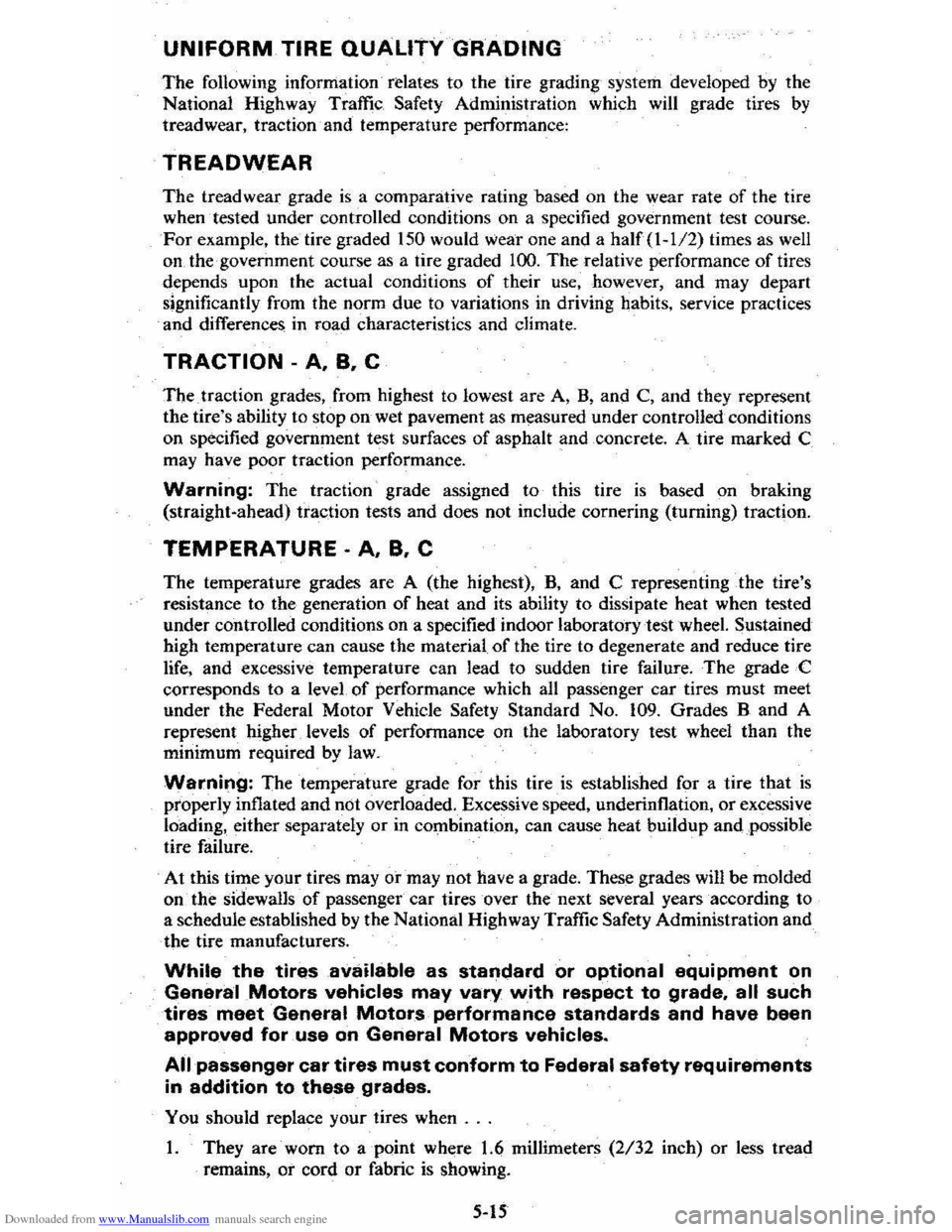
Downloaded from www.Manualslib.com manuals search engine UNIFORM TIRE QUALITY GRADING
The following information· relates to the tire grading system developed by the
National Highway Traffic
Safety Administration which will grade tires by tread wear, traction· and temperature performance:
TREADWEAR
The tread wear grade is a comparative rating based on the wear rate of the tire
when . tested under controlled conditions on a specified government test course.
For example, the tire graded 150 would Wear one and a half(l-1I2) times as well
on the government course as a tire graded 100. The relative performance of tires
depends upon the actual conditions
of their use, however, and may depart
significantly from the norm due to variations in driving habits, service practices
and differences in road characteristics and c1imate.
TRACTION -A. B. C
The. traction grades, from highest to lowest are A, B, and C, and they represent
the tire's ability to stop
on wet pavement as measured under controlled conditions
on
specified government test surfaces of asphalt and concrete. A tire marked C
may have poor traction performance.
Warning: The traction grade assigned to this tire is based on braking
(straight·ahead) traction tests and does not include cornering (turning) traction.
TEMPERATURE -A. B. C
The temperature grades are A (the highest), B, and C representing the tire's
resistance to the generation
of heat and its ability to dissipate heat when tested
under controlled conditions on a specified indoor laboratory teSt wheel. Sustained
high temperature can cause the material
of the tire to degenerate and reduce tire
life, and excessive temperature can lead to sudden tire failure.
The gradeC
corresponds to a level of performance which all passenger car tires must meet
under the Federal Motor Vehicle Safety Standard No. 109. Grades B and A
represent higher. levels
of performance on the laboratory test wheel than the
minimum required by law.
Warning: The temperature grade for this tire. is established for a tire that is
properly inflated and neit overloaded, Excessive speed, underinflation, or excessive
loading, either separately or in combination, can cause heat buildup and possible
tire failure,
At this time your tires mayor may not have a grade. These grades will be molded
on· the sidewal1s of passenger car tires over the next several years according to
a schedule established by the National Highway Traffic Safety Administration and
the tire manufacturers.
While the tires8vailable as standard or optional equipment on
General Motors vehicles may vary with respect to grade. all such tires meet General Motors performance standards and have been
approved for use on General Motors vehicles.
All passenger car tires must conform to Federal safety requirements
in addition to these grades.
You should replace your tires when ...
1. They are worn to a point where 1.6 millimeters (2/32 inch) or less tread
remains,
ot cord or fabric is showing.
5-\5
Page 77 of 95
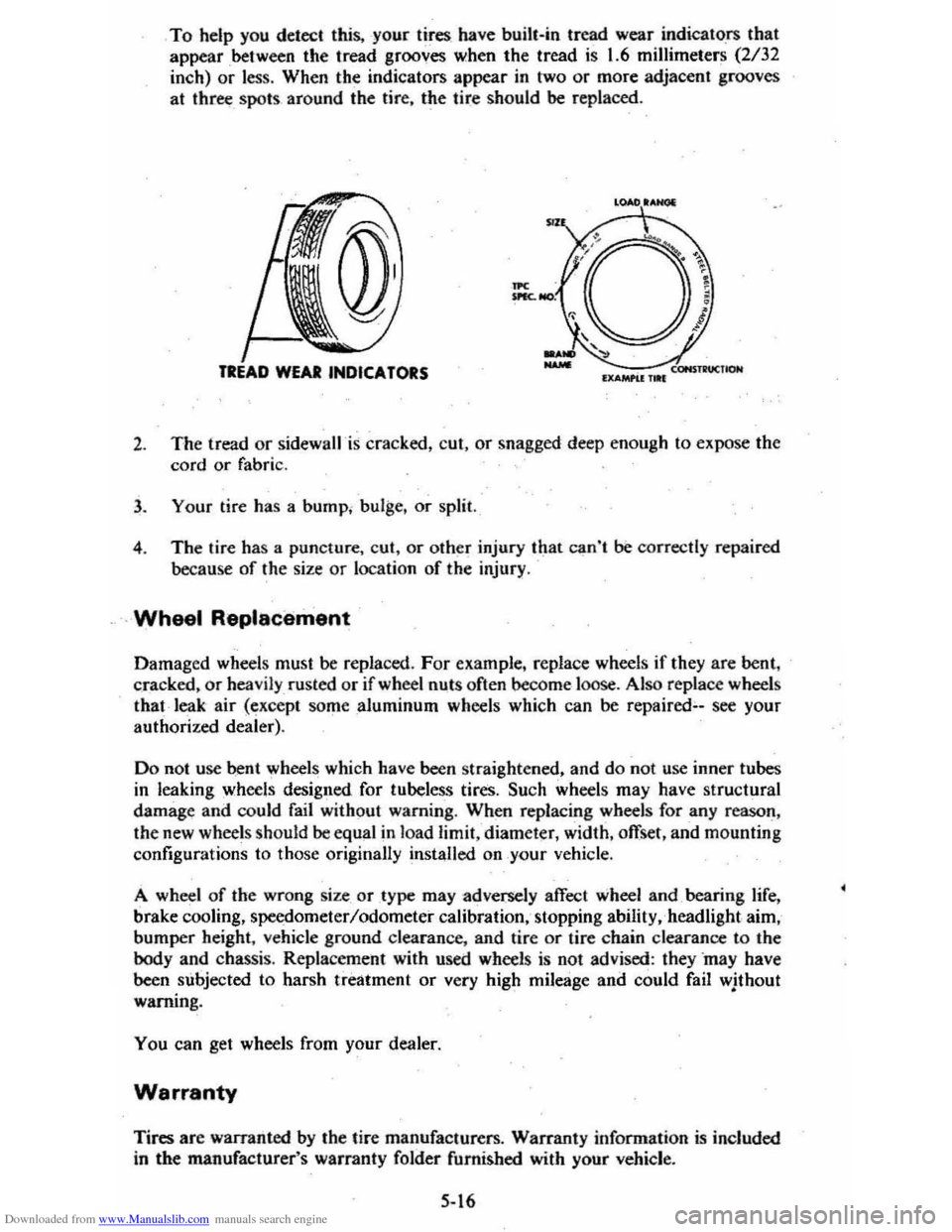
Downloaded from www.Manualslib.com manuals search engine To help you detect this, -your tires have bui1t-in tread wear indicato .fS that
appear between the tread grooves when the tread is 1.6 millimeters (2/32
inch)
or less . When the indicators appear in two or more adjacent grooves
at
three _ spots around the tire, the tire should be replaced .
LOAD lANal
''-----7.cONSTll"UCtlON IXAMI'U 1 .. 1
2. The tread or sidewall is cracked, cut, or snagged deep enough to expose the
cord
or fabric.
3 . Your tire has a bump . bulge. or split.
4 . The tire has a puncture . cut ,
or other injury that can't be correctly repaired
because of the size
or location of the injury .
. Wheel Replacement
Damaged wheels must be replaced . For example. replace wheels if they are bent .
cracked .
or heavily rusted or if wheel nuts often become -loose . Also replace wheels
that leak air (except someaJuminum wheels which can be repaired;.-see your
authorized dealer).
Do not use bent wheels which have been straightened, and do not use inner tubes
in leaking wheels designed for tubeless tires. Such wheels may have structural
damage and could fail without warning. When replacing wheels for any reason,
the new wheels should
be equal in load limit, diameter, width, offset, and mounting
configurations to those originally installed on your vehicle.
A wheel
of the wrong size. or type may adversely affect wheel and. bearing life,
brake cooling, speedometer/odometer calibration,· stopping ability, . headlight aim,
bumper height, vehicle ground clearance, and tire
or tire chain clearance to the body and chassis. Replacement with used wheels is not advised: they ·may have
been subjected to harsh treatment or very high mileage and could fail wjthout
warning .
You can get wheels from your dealer.
Warranty
Tires are warranted by the tire manufacturers. Warranty information is included
in the manufacturer's warranty folder furnished with your vehicle.
5-16
Page 78 of 95
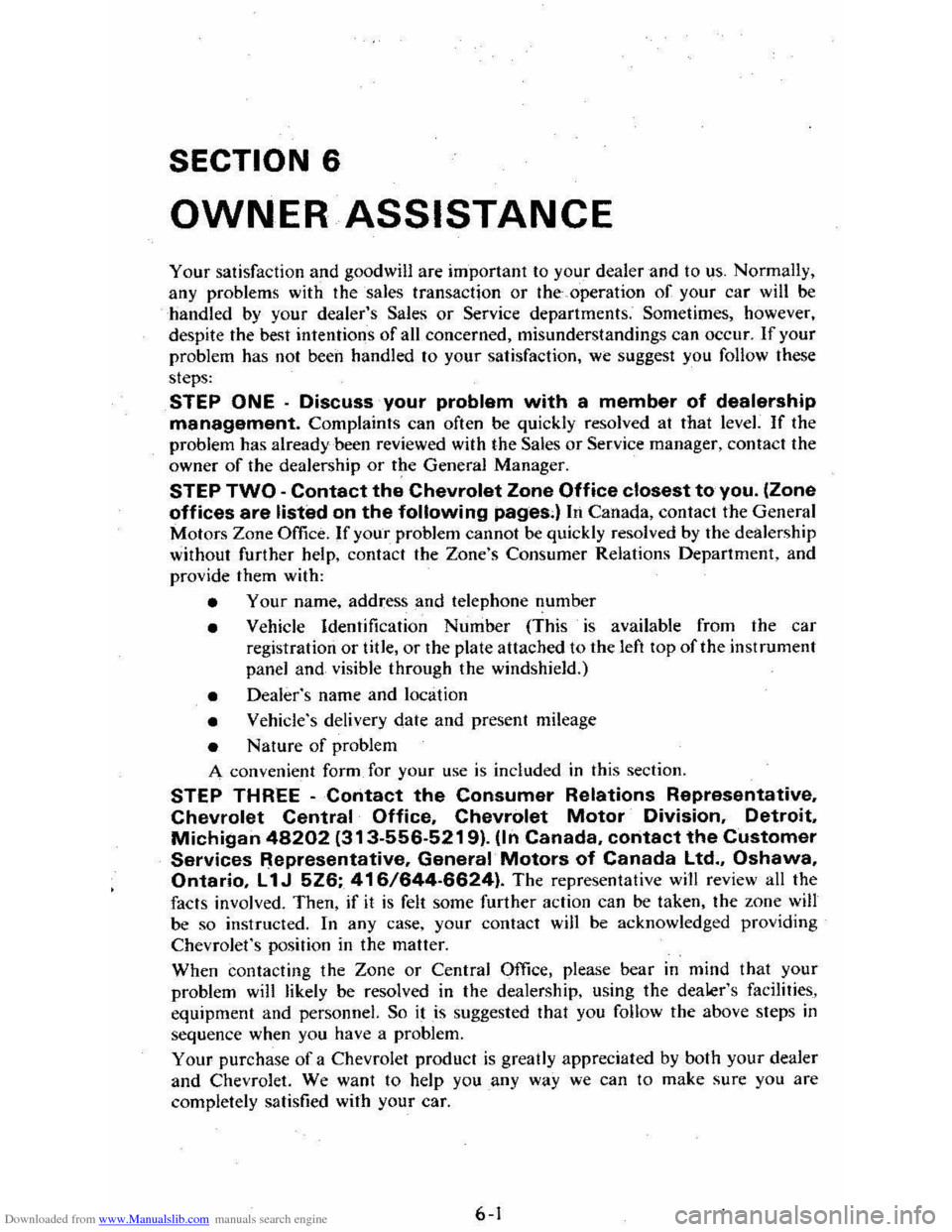
Downloaded from www.Manualslib.com manuals search engine SECTION 6
OWNER ASSISTANCE
Your satisfaction and goodwill are important to your dealer and to us. Normally,
any problems with the sales transaction or the-operation of your car will be
handled by your dealer's Sales or Service departments. Sometimes, however,
despite the best intentions of all concerned, misunderstandings can occur.
If your
problem has not been handled to your satisfaction, we suggest you follow these
steps:
STEP ONE -Discuss your problem with a member of dealership management. Complaints can often be quickly resolved at that level. If the
problem has already been reviewed with the Sales or Service manager, contact the
owner
of the dealership or t~e General Manager.
STEP TWO -Contact the Chevrolet Zone Office closest to you_ (Zone offices are listed on the following pages.) IIi Canada, contact the General
Motors Zone Office. If your problem cannot be quickly resolved by the dealership
without further help, contact the Zone's Consumer Relations Department, and
provide them with:
• Your name, address and telephone ~umber
• Vehicle Identification Number (This is available from the car registration or title, or the plate attached to the left top of the instrument
panel
and visible through the windshield.)
• Dealer's name and location
• Vehicle's delivery date and present mileage
• Nature of problem
A convenient form for your use
is included in this section.
STEP THREE -Contact the Consumer Relations Representative, Chevrolet Central Office, Chevrolet Motor Division, Detroit,
Michigan 48202 (313-556-S219)_ (In Canada, contact the Customer
Services ~epresentative. General· Motors of Canada Ltd .• Oshawa. Ontario, L1 J SZ6; 416/644-6624)_ The representative will review all the
facts involved. Then, if it is felt some further action can be taken, the zone will
be so instructed. In any case, your contact will be acknowledged providing
Chevrolet's position
in the matter.
When contacting the Zone or Central
Office, please bear in mind that your
problem will likely be resolved in the dealership, using the deaLer's facilities,
equipment and personnel.
So it is suggested that you follow the above steps in
sequence when you have a problem.
Your purchase
of a Chevrolet product is greatly appreciated by both your dealer
and Chevrolet. We want to help you
any way we can to make sure you are
completely satisfied with your car.
6-1
Page 79 of 95
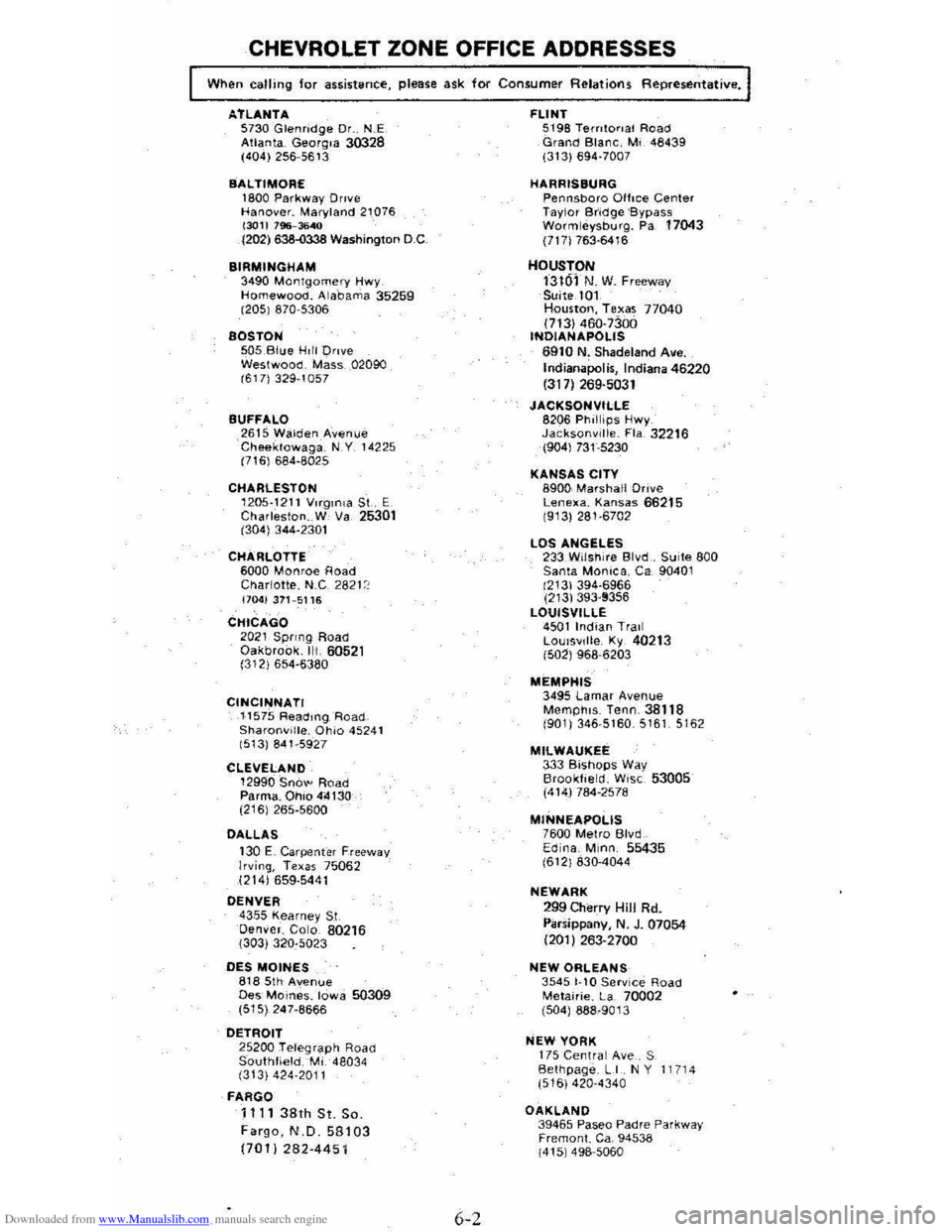
Downloaded from www.Manualslib.com manuals search engine CHEVROLET ZONE OFFICE ADDRESSES
When calling for assistance, please ask for Consumer Relations Representative .
.:.TlANTA 5730 Glenridge Dr._ N.E Atlanta. Georgia 30328 (404) 256-5613
BALTIMORE 1800 Parkway Drive
Hanover. Maryland 21076 (301) 796-3640 (202) 638-0338 Washington D.C
BIRMINGHAM 3490 Montgomery Hwy Homewood. Alabama 35259 (205) 870-5306
BOSTON 50S,Blue Hili Dnve Westwood, Mass 02090 (617) 329-1057
BUFFALO 2615 Walden Avenue
Cheektowaga, NY 14225
(716) 684-8025
CHAALESTON 1205-1211 V,rgm,a St E Charleston .. W Va. 25301
(304) 344-2301
CHARLOTTE 6000
Monroe Road
Charlotte. N.C 282P 1704) 371-5116
CHICAGO 2021 Spnng Road Oakbrook. III, 60521
(312) 654-6380
CINCINNATI 11575 ReadmgRoad Sharonville. Ohio 45241 1513) 841-5927
CLEVELAND 12990 5no\" Road
Parma. Ohio 44130 (216) 265-5600
DALLAS 130 E. Carpenter Freeway Irving, Texas 75062 1214J 659-5441 DENVER 4355 Kearney St
Denver. Colo. 80216 (303) 320:5023
DES
MOINES 818 5th Avenue Des Moines. Iowa 50309 (515)247-8666
DETROIT
25200 Telegraph Road Southfield,Mi 48034 (313) 424-2011
FARGO 1111 38th St. So. Fargo, N,D. 58103 (701) 282-445 i
6-2
FLINT 5198 Terntonal Road Grand Blanc, Mi 48439 (313) 694·7007
HARRISBURG Pennsboro Office Center
Taylor Bridge 'Bypass Wormleysburg. Pa, 17043 (717) 763-6416
HOUSTON 13101 N. W. Freeway Suite.lOl Houston, Texas 77040 (713) 460·7300 INDIANAPOLIS 6910 N. Shadeland Ave. Indianapolis, Indiana 46220 (317) 269·5031 JACKSONVILLE 8206 Phillips Hwy Jacksonville. Fla 32216 (904) 731-5230
KANSAS CITY 8900· Marshall Drive Lenexa. Kansas 66215 (913) 281·6702
LOS
ANGELES 233.Wilshire Blvd .. Suite 800
Santa Monica, Ca 90401 (213) 394·6966 (213) 393"!356 LOUISVILLE 4501 Indian Trail
LOUisville, Ky. 40213 (502) 968-6203
MEMPHIS 3495 Lamar Avenue MemphiS. Tenn, 38118 (901) 346-5160, 5161 5162
MILWAUKEE 333 Bishops Way BrOOkfield. Wisc 53005 (414) 784-2578
MINNEAPOLIS 7600 Metro Blvd Edina, Minn, 55435 (612) 830-4044
NEWARK 299 Cherry Hill Rd_ Parsippany, N. J_ 07054 (201) 263-2700
NEW ORLEANS 35451·10 Service Road
Metairie. La. 70002 (504) 888.9013
NEW YORK 175 Central Ave 5 Bethpage, LI, N Y 11714
(516) 420-4340
OAKLAND 39465 Paseo Padre Parkway Fremont. Col, 94538
{415) 498-5060
Page 80 of 95
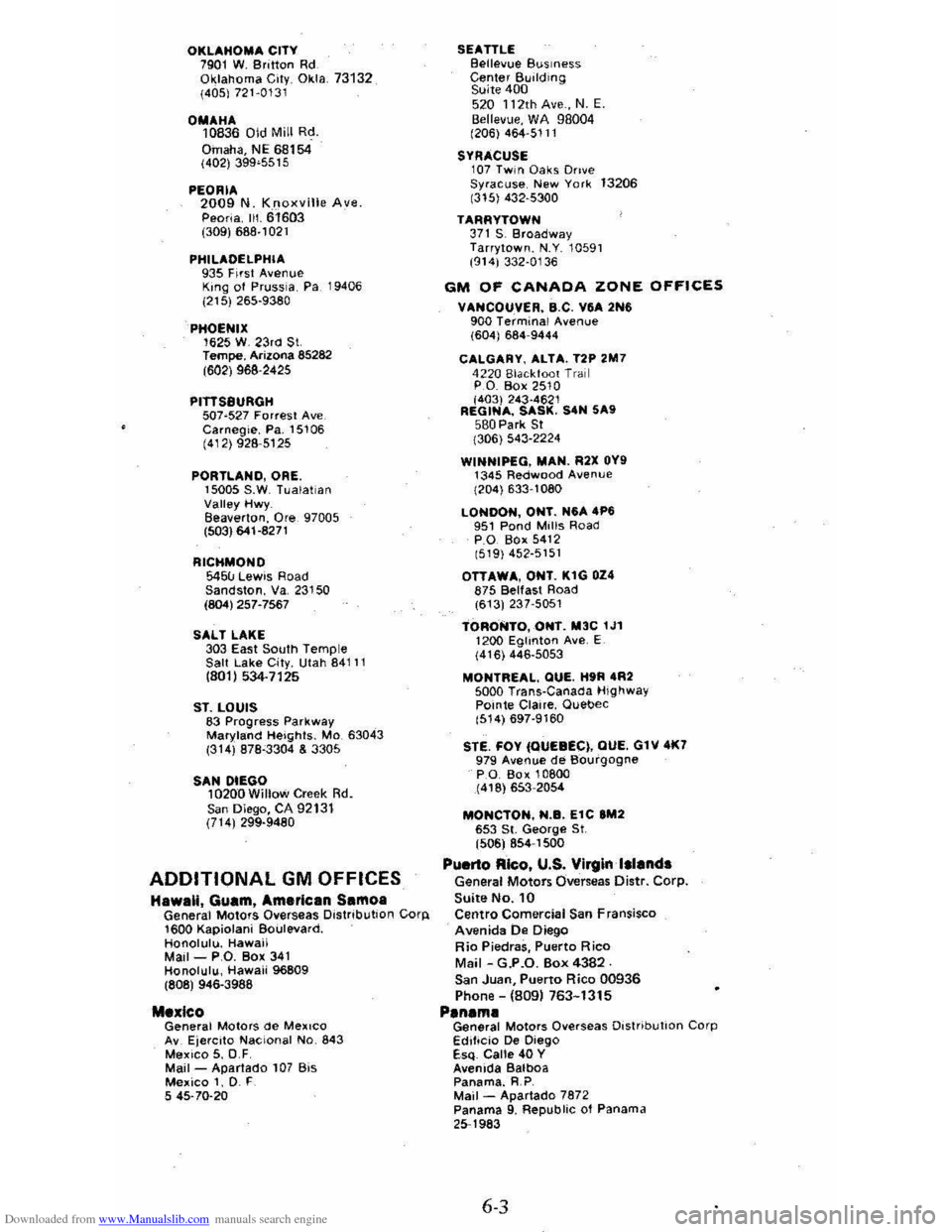
Downloaded from www.Manualslib.com manuals search engine OKL ... HOMA CITY 7901 W. Britton Rd Ok,lahoma City Ok,la 73132 (405) 721·0131
OM"'H'" 10836 Old Mill R<;I. Omaha, NE 68154 (402) 399'5515
PEORI ... 2009 N. Knoxville Ave. Peoria, III. 61603 (309) 688·1021
PHIL ... OELPHIA 935 First Avenue
King of Prussia Pa 19406 (215) 265-9380
PHOENIX 1625 W, 23rd 51 Tempe. Arizona 85282 (602) 968·2425
PITTSBURGH 507·527 Forrest Ave
Carnegie. Pa. 15106 (412) 928-5125
PORTLAND, ORE. 15005 S.W, Tualalian Valley Hwy
Beaverton. Ore 97005 (503) 641-8271
RICHMOND 545IJ lewis Road
Sandston. Va, 23150 (804) 257-7567
S ... LT LAKE 303 East South Temple Sail Lake City. Utah 84111 (801) 534-7125
ST. LOUIS 83 Progress Park,way Maryland Heights. Mo 63043 (314) 878'3304 & 3305
SAN DIEGO 10200WiUowCreek Rd. San Diego, CA 92131
(714) 299-9480
ADDITIONAL GM OFFICES Hawaii, Guam, A.merlcan Samoa General Motors Overseas Distribution Corll 1600 Kapiolani BOUlevard.
HonOlulu. Hawaii Mail-P,O. Box 341 Honolulu, Hawaii 96809 (808) 946-3988
Mexico General Motors de Me~lco Av Ejercito Nacionai No. 843 Mexico 5. O,F Mail-Apartado 107 Bis Mexico 1, D F 545-70-20
SE ... TTLE Bellevue BUSiness Center Building Suite 400 520 112th Ave .• N. E. Bellevue. WA 98004 (206) 464·5111
SYRACUSE 107 Twin Oaks DrIVe
Syracuse, New York 13206 (315) 432-5300
TARRYTOWN 371 S. Broadway Tarrytown. NY 10591 (914) 332-0136
GM OF CANADA ZONE OFFICES
V"'NCOUVER, B.C. V6'" 2N6 900 Terminal Avenue
(604) 684-9444
CALGARY .... LT .... T2P 2M7 4220 BI~GktQOt Trail PO. Box 2510 (403) 243-4621 REG IN ... , S"'SK. S4N 5A9 580 Park St (306) 543-2224
WINNIPEG, MAN. R2X OY9 1345 Redwood Avenue
(204) 633·1080
LONDON, ONT. N6'" 4P6 951 Pond Mills Road P.O. Box 5412 1519) 452-5151
OTTAWA, ONT. K1G 024 875 Belfast Road
(613) 237·5051
TORONTO,ONT. M3C 1J1 1200 Eglinton Ave, E (416) 446-5053
MONTRE ... L. QUE. H9R 4R2 5000 Trans-Canada Highway Pointe Claire. Quebec
(514) 697-9160
STE. FOY (QUEBEC), QUE. G1 V 4K7 979 Avenue de Bour'gogne PO, Box 10800 (418) 653·2054
MONCTON, N.B. E1C 1M2 653 51. George St (506) 854·1 500
Puerto Rico, U.S. Virgin ·1.land. General Motors Overseas Distr. Corp. Suite No. 10 Centro Comercial San F ransisco Avenida be Diego Rio Piedras, Puerto Rico Mail -G.p .0. Box 4382 . San Juan, Puerto Rico 00936 Phone -(809) 763-1315 Pan.m. General Motors Overseas Distribution Corp Edificio De Oiego ESQ. Calle 40 Y Avenida Balboa Panama. A.? Mail -Apartado 7872
Panama 9. Republic of Panama 25·1983
6-3